The Australian economy is ploughing into rising swells. There are five waves headed our way that might be rideable in isolation but if they converge would represent a perfect storm.
Consider. The structural backdrop for the economy is the mining investment cliff. Although it began two quarters ago, it is not until the second half of this year, probably Q3, that it begins to hit the employment market proper through the wind down of building and structures investment. It has a long way to fall after that (note the green line):
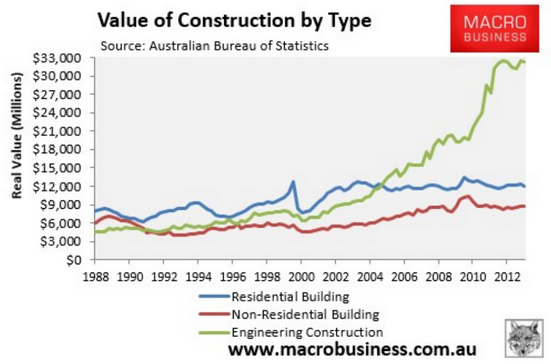
We’ve all known this for some time and interest rates have been cut to record lows to stimulate consumption to offset it. But that project has been seriously disrupted by the second wave, the Budget, which has rocked consumer confidence to its lowest point since the GFC:
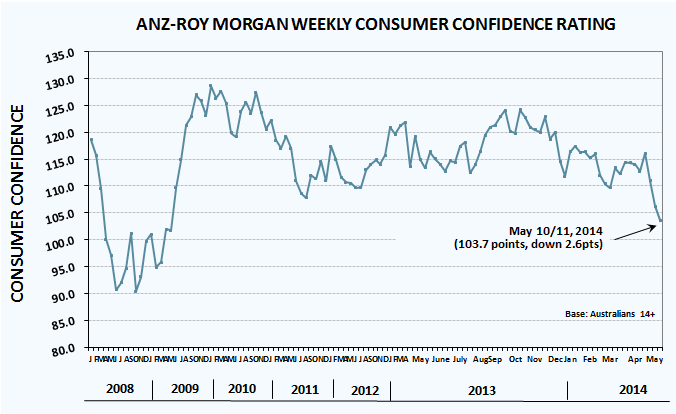
I’ve been happy to see some component of the the big falls as “sticker shock” that will pass. But the structure of Budget cuts and the growing social conflict around them means that the political wrangling is likely to run right through to Q3 and the weight on confidence will be more enduring. There is also the unquantifiable impact of the loss of faith in the Government (which was economically material last year) and the possibility that consumers accept that there has been an epochal shift for the worse in Australia’s fortunes. A range of polls over the weekend confirmed that Australians felt much worse off after the Hockey budget than any Swan or Costello effort, despite it being much less contractionary at the macro level.
The other effect of low interest rates has been to fire up east coast property and the Sydney market has, frankly, entered a parabolic blowoff top thanks to an investor mania (check out the blue line moon shot):
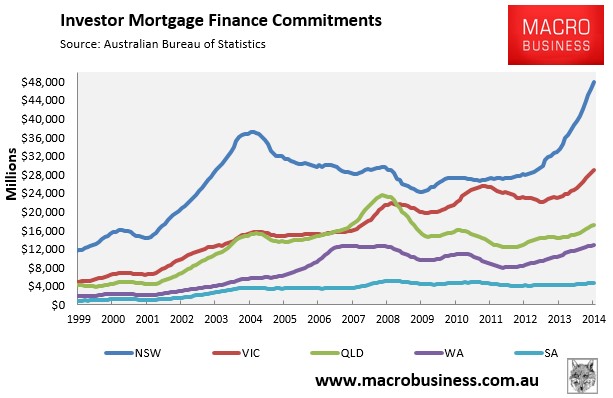
That is not the kind of pattern that deflates slowly. This is why the RBA is warning first home buyers to keep out of the market. House prices growth usually weakens through winter but the question is will they strengthen again in Q3 if consumer confidence remains suppressed? That’s my third wave. Sydney property looks toppy and only needs a shock to send it into sharp reverse.
Such a shock may well be coming from outside as well as inside the economy in Q3. Wave four is the iron ore price and mining equities, which are under intensifying pressure:
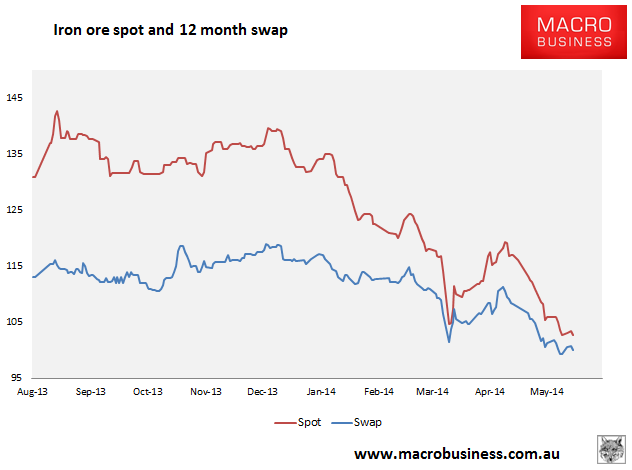
The iron ore market is very weak. Chinese steel production is strong but end-user demand is not as Chinese property declines and inventories of steel and iron ore are plentiful in China. That has led to a collapsing steel price which will force Chinese steel mills to destock raw materials at some point this year. The most likely candidate for that is Q3 on typical seasonal weakness which looks like it may converge with China’s gathering property bust.
If so, iron ore will fall to $80 or below in August or September (before rebounding somewhat). That will mean all of the Budget’s estimated terms of trade falls for next year will arrive instead in just one quarter. Fortescue Metals, as well as a swag of junior iron ore miners, will face another existential crisis.
All of this is transpiring as the fifth wave is washing over everything already. It is the Australian dollar which is happily levitating far above fair value on the global chase for yield and preventing tradeable sectors from rebounding. Here is the AFR’s David Bassanese’s chart (which is similar to that used by Treasury and Goldman Sachs):
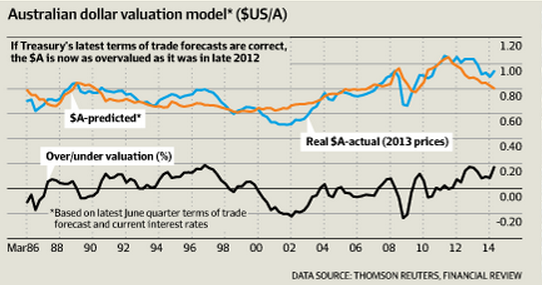
Remember, that’s fair value based upon commodity prices and interest rates overseas. It is still too high for the economy as it goes over a once per century mining investment cliff. In truth we need a much lower than fair value dollar for recovery. The high dollar is exacerbating mining and manufacturing woes, as well as rotting on the vine the low hanging fruits of recovery like tourism and education.
The possible convergence of these five negative waves in the third quarter would swamp the economy. Consumer confidence leads house prices and if it remains weak, and the external shock arrives, then Sydney and Melbourne housing could roll over just as mining-related job losses rise in WA and QLD as the Gorgon and QCLNG projects begin the construction wind down.
That’s an income shock, labour market stall and negative wealth effect plus public austerity. Real activity in the national economy will resemble last year’s second half domestic demand recession even if measures like net exports hold up, only this time housing will be coming off not rising.
I’m bringing forward my next rate cut to October, with a possible follow up soon afterwards. And that brings me to the real problem. If these events do converge, why would a lousy 50bps make much difference?

